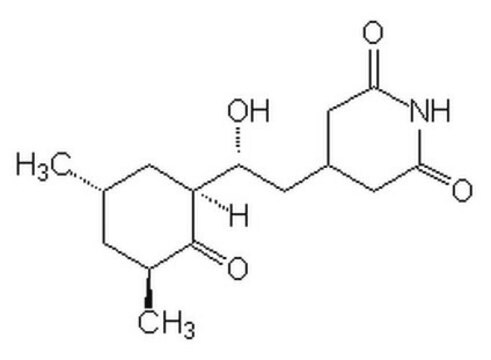239764
Cycloheximide, High Purity
Antifungal antibiotic that inhibits protein synthesis in eukaryotes but not in prokaryotes.
Sinónimos:
Cycloheximide, High Purity
About This Item
Productos recomendados
Quality Level
assay
≥98% (HPLC)
form
solid
potency
3.4 μM Ki
manufacturer/tradename
Calbiochem®
storage condition
OK to freeze
color
white
solubility
chloroform: soluble
ethanol: soluble
methanol: soluble
shipped in
ambient
storage temp.
10-30°C
InChI
1S/C15H23NO4/c1-8-3-9(2)15(20)11(4-8)12(17)5-10-6-13(18)16-14(19)7-10/h8-12,17H,3-7H2,1-2H3,(H,16,18,19)/t8-,9-,11-,12+/m0/s1
InChI key
YPHMISFOHDHNIV-FSZOTQKASA-N
General description
Biochem/physiol Actions
hFKBP12
Warning
Reconstitution
Other Notes
Lu, Q., et al. 1996. Arch. Biochem. Biophys.334, 175.
Chow, S.C., et al. 1995. Exp. Cell Res.216, 149.
Cotter, T.G., et al. 1992. Anticancer Res.12, 773.
Takano, Y.S., et al. 1991. J. Pathol.163, 329.
Waring, P. 1990. J. Biol. Chem. 265, 14476.
Legal Information
signalword
Danger
hcodes
Hazard Classifications
Acute Tox. 2 Oral - Aquatic Chronic 2 - Muta. 2 - Repr. 1B
Storage Class
6.1A - Combustible acute toxic Cat. 1 and 2 / very toxic hazardous materials
wgk_germany
WGK 3
flash_point_f
Not applicable
flash_point_c
Not applicable
Certificados de análisis (COA)
Busque Certificados de análisis (COA) introduciendo el número de lote del producto. Los números de lote se encuentran en la etiqueta del producto después de las palabras «Lot» o «Batch»
¿Ya tiene este producto?
Encuentre la documentación para los productos que ha comprado recientemente en la Biblioteca de documentos.
Nuestro equipo de científicos tiene experiencia en todas las áreas de investigación: Ciencias de la vida, Ciencia de los materiales, Síntesis química, Cromatografía, Analítica y muchas otras.
Póngase en contacto con el Servicio técnico






